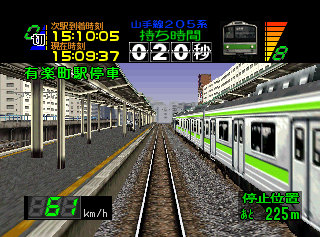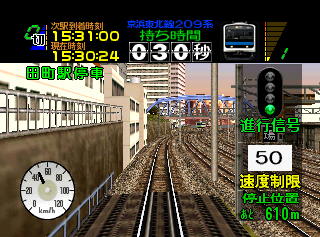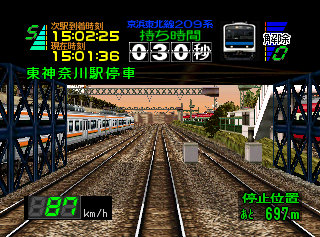« Kantō Region »
- Train Lines: Keihin-Tōhoku Line (京浜東北線) and Yamanote Line (山手線)
- Total Distance (in-game): ?km (Keihin-Tōhoku Line), 13.1km (Yamanote Line)
- Number of stations (in-game): 18 (Keihin-Tōhoku Line), 14 (Yamanote Line)
- Train Route: Image (Keihin-Tōhoku Line), Image (Yamanote Line)
- Number of stages: 4 (four) - 3 in the N64 version
Stages
| Train (Keihin-Tōhoku Line) |
 |
 |
 |
|
|---|---|---|---|---|
| 209 | 209 | 209* | ||
| Rapid | Local | Rapid | ||
| Yokohama | 横浜 | ■ | ■ | |
| Higashi-Kanagawa | 東神奈川 | ■ | ■ | |
| Shin-Koyasu | 新子安 | ■ | ■ | |
| Tsurumi | 鶴見 | ■ | ■ | |
| Kawasaki | 川崎 | ■ | ■ | |
| Kamata | 蒲田 | ■ | ■ | |
| Ōmori | 大森 | ■ | ■ | |
| Ōimachi | 大井町 | ■ | ■ | |
| Shinagawa | 品川 | ■ | ■ | ■ |
| Tamachi | 田町 | ■ | ■ | |
| Hamamatsuchō | 浜松町 | | | | | |
| Shimbashi | 新橋 | | | | | |
| Yūrakuchō | 有楽町 | | | | | |
| Tōkyō | 東京 | ■ | ■ | |
| Kanda | 神田 | | | | | |
| Akihabara | 秋葉原 | ■ | ■ | |
| Okachimachi | 御徒町 | | | | | |
| Ueno | 上野 | ■ | ■ | |
| Stage Difficulty | 3c | 3c | 3c | |
* Unavailable in the N64 version. The section from Shinagawa to Ueno is only playable if you get a Great when stopping at Shinagawa.
| Train (Yamanote Line) |
 |
|
|---|---|---|
| 205 | ||
| Local | ||
| Tōkyō | 東京 | ■ |
| Yūrakuchō | 有楽町 | ■ |
| Shimbashi | 新橋 | ■ |
| Hamamatsuchō | 浜松町 | ■ |
| Tamachi | 田町 | ■ |
| Shinagawa | 品川 | ■ |
| Ōsaki | 大崎 | ■ |
| Gotanda | 五反田 | ■ |
| Meguro | 目黒 | ■ |
| Ebisu | 恵比寿 | ■ |
| Shibuya | 渋谷 | ■ |
| Harajuku | 原宿 | ■ |
| Yoyogi | 代々木 | ■ |
| Shinjuku | 新宿 | ■ |
| Stage Difficulty | 4c | |
| Stopping Station (停車駅) | ■ |
| Passing Station (通過駅) | | |
| Stop/Pass (random) | ◆ |
Screenshots



Notes
Welcome to Tōkyō! And the region around it as well. This area is full of many train lines, which is expected of an area with so much movement during the entire day. The game actually puts two separate lines here, Yamanote Line and Keihin-Tōhoku Line, both operated by JR East. While they are close enough to the point where many stations are served by both lines, there's still quite a few differences between both.
The Yamanote Line is a circular train line, which has trains going both clockwise and counterclockwise, all of them are local and stop by all stations. It doesn't actually make a perfect circle, though, it's more of an upside-down egg. In this game you only end up seeing a small portion of it. It has probably one of the most recognizable trains, the 205 series, which have sadly already been replaced by newer trains.
The Keihin-Tōhoku Line is a normal train line that passes by some of the stations on the eastern side of the Yamanote Line. While most trains are local, some trains during certain hours become rapid trains, skipping a few stations where it runs parallel to the Yamanote Line and only stopping on the more movement-heavy ones. Again, not all of this line's stations appear in the game.
You can hear more about these two train lines on Wikipedia by clicking these links: Yamanote Line - Keihin-Tōhoku Line
